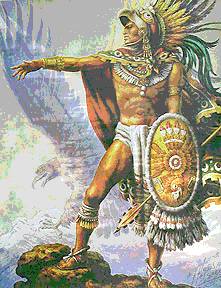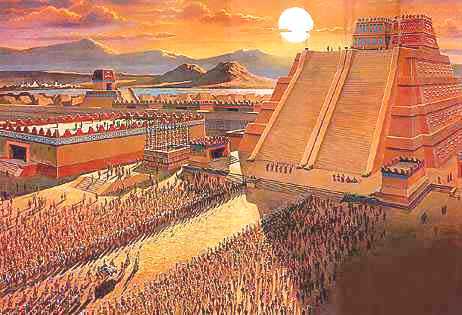The Aztecs, or more properly, the Mexicas, for whom the later Republic of Mexico was named, were a Mesoamerican people of central Mexico in the 14th, 15th and 16th centuries. They were a civilization with a rich mythology and cultural heritage. Their capital was Tenochtitlan, built on raised islets in Lake Texcoco – the site of modern-day Mexico City. The Aztec empire produced the biggest demographic explosion in Mesoamerica: the population grew from an estimated 10 million to 15 million.

Aztec warrior
Nomenclature
Aztec is usually used as a historical term, although some contemporary Nahuatl-speakers would consider themselves Aztecs. More particularly, the term refers to the empire of the Mexicas as distinguished from the Mexicas alone. This article deals with the historical Aztec civilization, not with modern-day Nahuatl speakers.
In Nahuatl, the native language of the Mexicas, Azteca means "someone who comes from Aztlán", a mythical place commonly believed to be located in northern Mexico or the Southwest U.S. (though there is great doubt about this, see current debates in Mexica scholarship), so this name was applied to other cultures of the same cultural group. However, the culture we call now Aztec referred to themselves as Mexica (IPA: [meihkah]) or Tenochca and Tlatelolca according their city of origin. Their use of the word azteca was like the modern use of Latino, or Mediterranean: a broad term that does not refer to a specific culture.
Alexander von Humboldt originated the modern usage of Aztec as a collective term applied to all the people linked by trade, custom, religion , and language to the Mexica state, the Triple Alliance. The term was adopted by Mexican scholars of 19th century, as a way to distance "modern" Mexicans from pre-conquest Mexicans. This has become controversial in more recent years, and consequently, the more proper usage "Mexica" is increasingly applied.
Mexica, the origin of the word Mexico, is a term of uncertain origin. Very different etymologies are proposed: the old Nahuatl word for the sun, the name of their leader Mexitli, a type of weed that grows in Lake Texcoco. The most renowned Nahuatl translator, Miguel León-Portilla, suggests that it means "navel of the moon" from Nahuatl metztli (moon) and xictli (navel) or, alternatively, it could mean navel of the maguey (Nahuatl metl).

Aztec pyramid
Government
The Aztec Empire is not completely analogous to the empires of European history. Like most European empires, it was ethnically very diverse, but unlike most European empires, it was more a system of tribute than a single system of government. Arnold Toynbee in War and Civilization analogizes it to the Assyrian Empire in this respect.
Although cities under Aztec rule seem to have paid heavy tributes, excavations in the Aztec-ruled provinces show a steady increase in the welfare of common people after they were conquered. This probably was due to an increase of trade, thanks to better roads and communications, and the tributes were extracted from a broad base. Only the upper classes seem to have suffered economically, and only at first. There appears to have been trade even in things that could be produced locally: love of novelty may have been a factor. There was even trade with cities considered enemies. The Purepechas, the only people who defeated the Aztecs, were the main source of copper axes.
0 comments:
Post a Comment